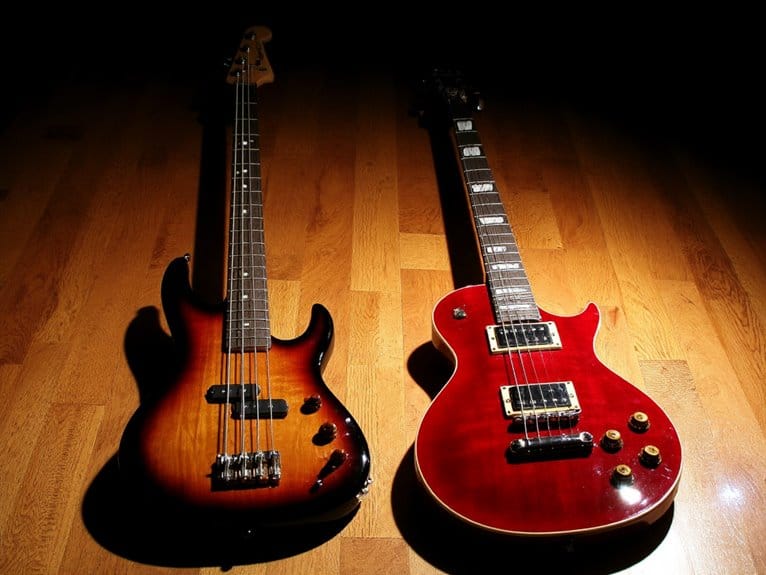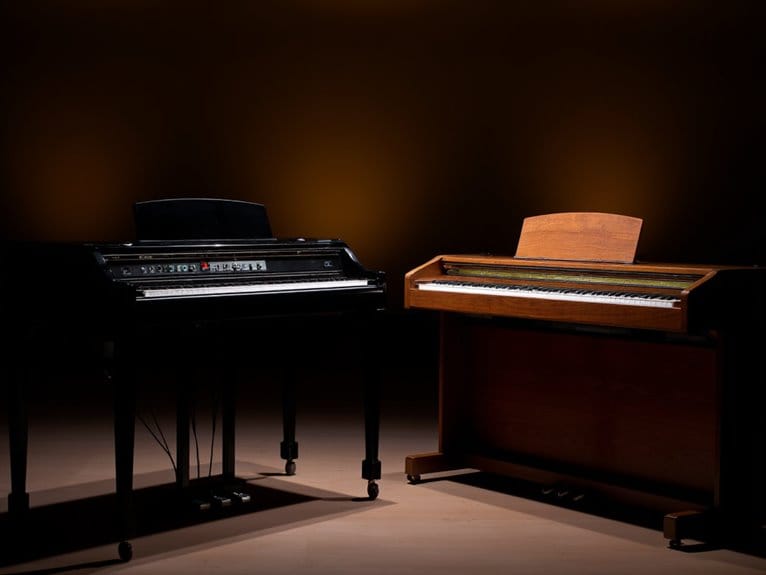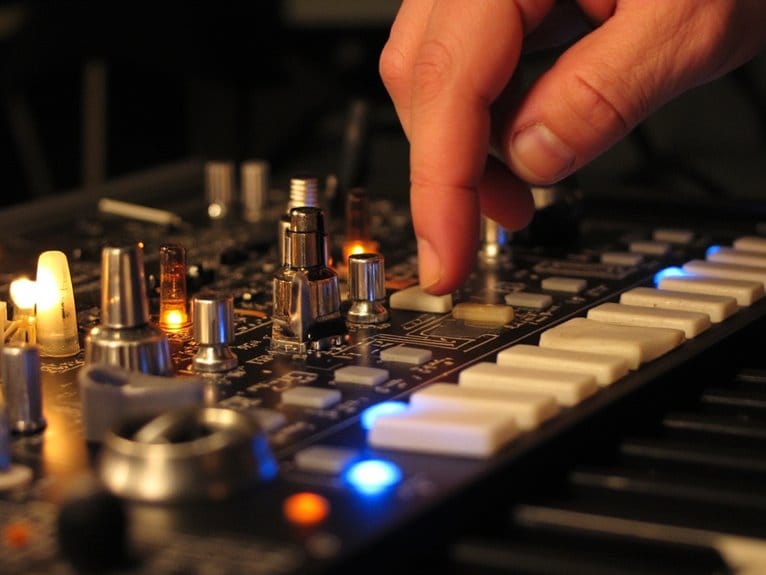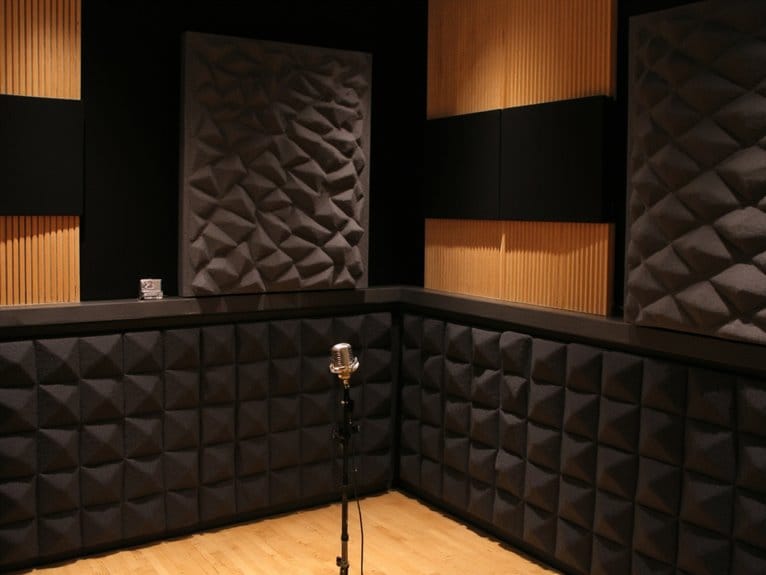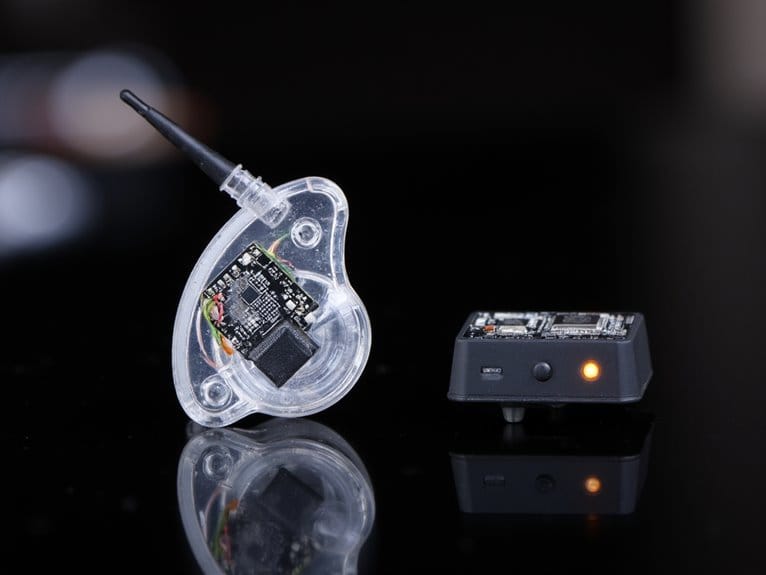What Is a Bass Guitar and How Does It Differ From Regular Guitar
A bass guitar differs from regular guitar through its larger body, longer 34-inch neck, and thicker strings that produce frequencies one octave lower, typically tuned E-A-D-G. You’ll notice it provides the rhythmic foundation and harmonic structure in musical arrangements, operating primarily in the 40-400 Hz range compared to guitar’s midrange frequencies above 80 Hz. The heavier construction, wider fretboard, and specialized playing techniques like fingerstyle and slap create distinctive warm, fundamental tones that anchor the groove—though these differences reveal just the surface.
We are supported by our audience. When you purchase through links on our site, we may earn an affiliate commission, at no extra cost for you. Learn more.
Notable Insights
- Bass guitars have larger bodies, longer necks (34 inches), and thicker strings designed for producing lower frequencies.
- Standard bass tuning is E-A-D-G, one octave below a regular guitar’s lowest four strings.
- Bass operates in lower frequencies (40-400 Hz) while regular guitar covers midrange frequencies starting around 80 Hz.
- Bass provides rhythmic foundation and harmonic support, bridging percussion and melody instruments in musical arrangements.
- Playing techniques differ significantly, requiring mastery of thicker strings and specialized methods like slap and pop.
Physical Design and Construction Differences
When I first picked up a bass guitar after years of playing electric guitar, the sheer difference in physical presence was immediately apparent – these instruments aren’t just scaled-up versions of their six-string counterparts, but rather purposefully engineered machines designed around fundamentally different sonic requirements.
The body design immediately stands out, featuring a larger, bulkier construction that’s specifically engineered to support and resonate lower frequencies effectively. You’ll notice the longer neck extends the typical 34-inch scale length, compared to your electric guitar’s 24.75 to 25.5 inches, which accommodates thicker strings and higher tension requirements. The larger construction can be heavier and challenging for smaller players to manage comfortably. Some bass guitars focus on lightweight construction for ease of play during extended sessions, which can significantly reduce player fatigue.
The hardware features reflect this robust construction approach, with heavier tuning machines, reinforced bridges, and wider fretboards that can handle the physical demands of bass playing. Most bass guitars come equipped with four strings tuned to E-A-D-G, though five and six-string configurations are also available for extended range playing. The choice of body material significantly affects the instrument’s tone, sustain, and overall sonic character, with options like basswood offering balanced characteristics while mahogany provides warmer tones with enhanced sustain. Quality bass guitars often feature split-coil pickups that deliver warm, versatile tones suitable for various musical genres.
String Configuration and Tuning Systems
When you’re comparing bass guitars to regular six-strings, you’ll immediately notice that most basses come with four strings instead of six, though five and six-string versions have gained serious traction in modern music.
Your standard four-string bass uses E1, A1, D2, G2 tuning, which sits exactly one octave below the lowest four strings of a regular guitar, giving you that foundational low-end that anchors most songs.
I’ve found that this difference in string count and tuning creates entirely different playing possibilities, since you’re working with perfect fourth intervals throughout the bass fingerboard, unlike the mixed intervals you’d encounter on a standard guitar. When setting up your bass, you’ll need to cut each string to specific lengths before winding them on the tuning posts to ensure proper installation and optimal performance.
String Count Differences
Four strings might seem limiting compared to a guitar’s six, but I’ve found that bass guitars achieve remarkable versatility through their strategic string configurations and tuning systems.
Standard 4-string basses use E-A-D-G tuning, providing essential low-end foundation, while 5-string models add either a low B string for extended range or a high C for melodic possibilities.
The string variety available today includes 6-string configurations with both B-E-A-D-G-C tuning, though honestly, most players stick with 4 or 5 strings for practical reasons.
These playability factors matter because thicker bass strings require wider spacing and different finger techniques than regular guitars.
The consistent fourth-interval tuning across all strings simplifies scale patterns, making bass surprisingly accessible despite its fewer strings.
Standard Tuning Variations
While most bass players start with standard E-A-D-G tuning, I’ve discovered that exploring alternative tuning variations can dramatically expand your instrument’s tonal palette and playing possibilities.
Drop D tuning, where you lower the E string to D, opens up heavier, deeper tones that work brilliantly for rock and metal genres. I’ve also experimented with tenor bass tuning (A-D-G-C), which omits the low E entirely for brighter, more melodic applications.
Different tuning styles require specific string gauges to maintain proper tension and playability—thicker strings handle lower tunings better, while lighter gauges work well for higher-pitched configurations.
Unlike guitar tuning with its mixed intervals, bass maintains consistent fourth intervals across most variations, making transposition and scale patterns more predictable regardless of your chosen tuning approach.
When switching to alternative tunings, carefully consider your string gauge selection as heavier gauges provide more volume and sustain for lower tunings, while lighter options facilitate easier bending for higher-pitched configurations.
Musical Range and Frequency Spectrum
When you pick up a bass guitar, you’re entering a sonic territory that sits roughly one octave below a regular guitar, with your fundamental frequencies spanning from about 40 Hz on that low E string up to 400 Hz when you’re fretting high notes on the G string.
Your instrument occupies the vital sub-bass and bass frequency ranges that provide the foundational low-end power most listeners feel rather than clearly hear, while regular guitars operate primarily in the midrange frequencies starting around 80 Hz and extending well beyond 1 kHz.
This frequency separation means you’re not just playing lower notes, you’re filling an entirely different role in the harmonic spectrum, one that anchors the rhythm section and gives music its physical presence and warmth.
Octave Differences Between Instruments
Understanding the octave differences between bass and regular guitars reveals why these instruments occupy such distinct sonic territories in music, with the bass guitar fundamentally operating about one octave below its six-string counterpart.
When you explore this octave exploration, you’ll discover that bass guitars typically span from 40 Hz to 400 Hz, while regular guitars start around 82 Hz and extend beyond 1,300 Hz.
This frequency overlap occurs mainly where bass’s higher notes meet guitar’s lower register, creating some shared sonic territory around 392-400 Hz.
Just as quality saxophone microphones should cover a 20 Hz to 20 kHz frequency spectrum to capture full tonal range and harmonic nuances, understanding the complete frequency response of bass guitars helps explain why they produce such rich, fundamental tones that form the backbone of most musical arrangements.
The pickup configuration significantly impacts this tonal character, with single-coil pickups providing brighter frequencies while humbucking pickups deliver warmer, fuller sound across the frequency spectrum. Professional recording setups often utilize 48kHz/24-bit audio quality to accurately capture these subtle tonal variations across the entire frequency range.
Key Octave Relationships:
- Standard tuning places bass strings (E1, A1, D2, G2) one octave below guitar’s lowest four strings
- Five-string basses extend down to 31 Hz, while six-string variants reach up to 523 Hz
- Harmonic content allows bass frequencies to reach 4-5 kHz, maintaining clarity despite low fundamentals
Frequency Range Comparison
Since we’ve established how bass guitars operate roughly one octave below regular guitars, I’ll explore the specific frequency spectrum that makes this relationship so musically significant. Understanding frequency response helps you make better mixing considerations and tonal adjustments across various music genres.
| Frequency Range | Bass Guitar | Regular Guitar |
|---|---|---|
| Fundamentals | 40Hz-400Hz | 82Hz-880Hz+ |
| Harmonics | Up to 5kHz | Up to 8kHz+ |
| Primary Zone | Sub-bass/Bass | Midrange |
Bass guitars dominate the 40-400Hz spectrum, providing foundational support that regular guitars can’t match. However, bass effects and harmonics extend much higher, creating overlap zones essential for EQ strategies. This frequency separation enables effective sound amplification and sound reinforcement in recording techniques, ensuring each instrument occupies its best sonic space without masking conflicts across genre applications. Many modern bass guitars feature dual pickups that allow players to blend different tonal characteristics and optimize their frequency response for specific musical styles. Managing the dynamic range of these frequencies becomes crucial during both live performances and studio recording sessions. Professional bass guitar setups often require amplifiers with sufficient power output to reproduce these low frequencies accurately in live performance settings.
Harmonic Foundation Roles
Beyond frequency ranges, the bass guitar’s most essential responsibility involves establishing the harmonic foundation that holds your entire musical arrangement together. It functions as both the rhythmic anchor and tonal reference point that other instruments depend on.
This harmonic support creates the underlying structure that defines chord identity through root notes, while your bass work with the drummer provides significant rhythmic stability that makes listeners move to the beat.
Here’s how bass guitars establish harmonic foundation:
- Root Note Definition – You’ll emphasize chord roots and fifths that clarify harmonic progressions and maintain tonal unity across the ensemble.
- Rhythmic Partnership – Your basslines lock with drum patterns, particularly kick drums, creating the fundamental groove that drives tempo and feel.
- Emotional Expression – You’ll shape the song’s character through stylistic techniques like walking bass, slap bass, and melodic counter-lines that enhance harmonic texture.
Role and Function in Musical Arrangements
When you listen to your favorite song, the bass guitar is working behind the scenes as both the rhythmic anchor and harmonic foundation that holds everything together.
I’ve observed how the bass creates groove dynamics by locking with the drums, establishing that essential pulse that makes you move to the music.
The bass and drums create an irresistible rhythmic foundation that compels your body to move with the music’s pulse.
While providing melodic support through chord tones and root notes, the bass acts as a musical bridge between percussion and harmony instruments, connecting rhythm with melody in ways that aren’t immediately obvious but are absolutely vital.
Different genres demand varying bass approaches, from simple root support in basic rock arrangements to complex walking lines in jazz, demonstrating the instrument’s remarkable versatility in shaping musical texture and maintaining harmonic clarity across diverse musical styles. Jazz bassists often require instruments with tonal flexibility to accommodate the genre’s sophisticated harmonic progressions and improvised passages.
The bass guitar’s sound quality is significantly influenced by pickup configurations, which range from single-coil to H-H setups that help deliver the optimal tonal output for each specific genre’s requirements. Many professional bass guitars feature split-coil pickups that provide enhanced tonal options for musicians across different playing styles.
Playing Techniques and Performance Styles
Four fundamental approaches define how you’ll attack the bass strings, each producing distinctly different tonal characteristics that I’ve found essential for adapting to various musical contexts.
This technique diversity shapes your sound dramatically, from fingerstyle’s smooth consistency across rock and jazz to pick playing’s aggressive precision in metal genres.
Your performance dynamics depend heavily on string attack methods and hand positioning choices:
- Fingerstyle versus pick technique – Index and middle finger plucking creates warmth, while picks deliver sharper attack and increased speed for complex passages.
- Slap and pop combinations – Thumb strikes and finger snaps generate percussive funk tones, popularized by legends like Larry Graham.
- Strategic hand positioning – Bridge proximity yields bright punch, while fretboard placement produces fuller, harmonic-rich tones for expressive musical passages.
Professional bassists often rely on preamp pedals to enhance their tonal flexibility and improve overall sound quality during both live performances and studio recordings.
When connecting your bass to recording equipment or live sound systems, using a DI box ensures optimal signal transfer while eliminating unwanted noise and interference that can compromise your performance quality.
Many bassists also utilize noise gates to minimize unwanted background interference, particularly during live performances where stage volume and electronic interference can affect signal clarity.
Sound Characteristics and Tonal Qualities
The techniques you master shape your attack, but your bass’s inherent tonal character emerges from a complex interplay of materials, electronics, and setup choices that I’ve learned to appreciate through years of experimenting with different instruments.
Bass tonalities span from warm, rounded lows to bright, articulate highs, with sound richness developing through careful balance of fundamental frequencies and overtones. Your instrument’s harmonic complexity comes from pickup placement, string choice, and playing position—factors that markedly affect tonal clarity and acoustic resonance.
I’ve found that dynamic response varies greatly between active and passive electronics, while low end emphasis depends heavily on your amp’s EQ settings around 250 Hz. Achieving proper tonal definition requires managing muddiness without sacrificing the fullness that makes bass so foundational. When performing live, higher wattage amplifiers produce cleaner, more defined bass tones that cut through the full band mix.
Your choice between stainless steel and nickel-plated strings further influences your instrument’s tonal character, with stainless steel offering superior brightness and longevity while nickel-plated options provide a warmer, more balanced sound. Extended-range instruments with six strings offer enhanced harmonic possibilities through unique chord progressions and greater tonal exploration.
Learning Requirements and Skill Development
Beginning bass guitarists often underestimate the investment required for proper skill development, but I’ve discovered through teaching countless students that establishing the right foundation from day one makes all the difference between frustrating practice sessions and steady progress.
Your learning journey demands specific foundational techniques that differ greatly from regular guitar approaches, requiring dedicated practice strategies tailored to bass-specific challenges like thicker strings and longer neck stretches.
Here’s what you’ll need to prioritize:
- Equipment setup – A quality bass amplifier with headphone capabilities, wide comfortable strap, and bass-specific tuner for accurate low-frequency detection.
- Fundamental skills – Master root note identification, basic scales, and proper finger placement before advancing to complex techniques.
- Structured practice routine – Establish consistent daily sessions using metronomes and play-along tracks to develop timing precision.
Most beginners find that 10 to 20 watts provides adequate power for home practice while offering the flexibility to jam with other musicians as skills develop.
Frequently Asked Question
How Much Does a Decent Beginner Bass Guitar Typically Cost?
You’ll find decent beginner bass guitars typically cost $200-$500, with quality budget options starting around $200. These beginner features include stable tuning, good playability, and reliable construction that’ll support your learning without breaking the bank.
Do I Need Special Picks or Should I Play Bass With Fingers?
You don’t need picks initially – fingerstyle technique is recommended for beginners since it builds fundamental skills and offers warmer tone. If you later want brighter, aggressive sound, thicker bass picks work better than guitar picks for proper pick selection.
Can Bass Guitars Be Played Through Headphones for Silent Practice?
You can achieve silent practice with your bass by connecting it to headphone amplifiers, audio interfaces, or multi-effects pedals with headphone outputs, since electric basses need amplification to be heard clearly through headphones.
Are Left-Handed Bass Guitars Readily Available or Harder to Find?
You’ll find left handed options exist but face availability challenges compared to right-handed models. Major brands offer fewer choices, higher prices, and limited store inventory, often requiring online orders or custom builds.
On a final note
Now that you’ve explored the fundamental differences between bass and regular guitars, you’ll understand why each instrument serves distinct musical purposes. Whether you’re drawn to the bass’s rhythmic foundation or the guitar’s melodic versatility, both instruments offer unique rewards for dedicated players. Your choice ultimately depends on your musical interests, physical preferences, and the specific role you’d like to fill in musical ensembles and performances.

